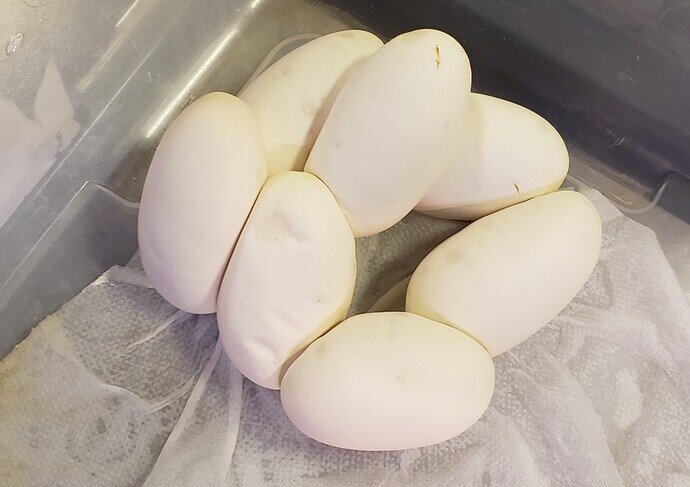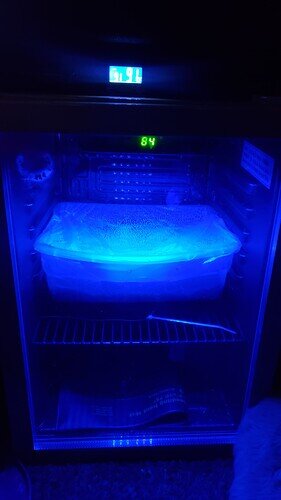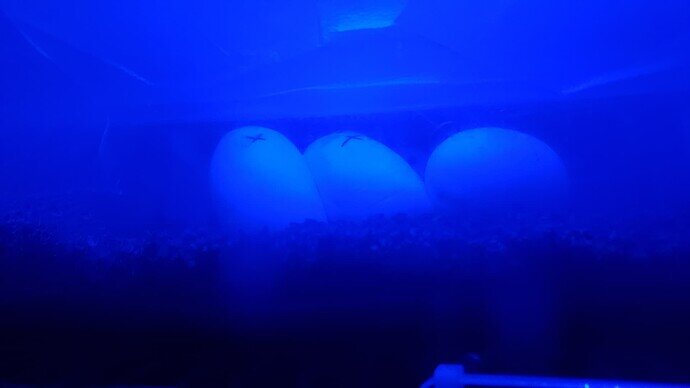I recently just had my first clutch a ball python eggs that was produced by my two visual albinos. I was not expecting the female to lay for another couple of days so when I found the clutch I was surprised and it was late in the afternoon. Once I pulled the eggs they had been together for too long and I could not confidently separate them without tearing or risk damaging any of the eggs. I put them directly in the patching medium I’m using and placed them in the incubator. Because I could not separate them it was hard to Candle them effectively and so I just placed them in the incubation box in the same orientation that the female had laid them in. After a week or so I was developing too much condensation on the bottom side of the press and seal and it was beginning to drip down on the eggs so I had to pull the box out of the incubator to replace the press and seal. At this time I used a high-powered flashlight to try the candle the eggs from the side as best I could and I noticed it appears a large number of the eggs have mostly veins on the top and it appears that the embryos maybe on the bottom side of a lot of the eggs. Is this going to cause them to drown and cause my clutch to fail. They have been incubating for about three and a half weeks now. If a majority of the embryo seem to be on the bottom side of the cluster, should I turn them over or is it too late to change anything at this point? I’m starting to really stress out because after two and a half years of raising up these snakes and getting to this point I hope I have not made a rookie mistake and ruined these seven beautiful looking eggs.
There have been some studies done indicating higher rates of survival with the embryos oriented at the top of the egg but I think the difference it makes is minimal. Many breeders have the “how they lay is how they stay” philosophy and it works great. If I don’t get to the eggs shortly after they lay I don’t stress about putting them all in the egg box in that same way they are oriented from mom. While I do candle and orient the embryos upward when I do separate them I think the main benefits of doing so are if an egg goes bad during incubation it is easily removable and to lay out the eggs in the egg box in the most efficient manner. When they’re all stacked onto each other there’s not enough space to avoid the top and sides in many tubs.
What I am concerned about though is that your egg box was developing so much condensation that it is literally dripping down onto the eggs from the press n seal. That shouldn’t happen if there are no eggs touching the press n seal or the the sides. I load my tubs up with water and I’ve never had dripping from the press n seal onto the eggs. I’m not sure what’s going on there.
I would cease removing the eggs and candling them further. Leave them alone and let them do their thing. If too much condensation is occurring and dripping down with press n seal you may want to remove it but, again, not sure what’s going on there. Make absolutely sure the eggs aren’t touching the press n seal or the sides anywhere.
Do you have a fan running in your incubator l? How big is it? How is your tape configured.
Condensation needs warm air and a cold surface to happen. Increasing air flow increases air mixing ensuring an even temp throughout should stop it.
The eggs are not touching the sides of the tub or the press and seal. I’m using a fairly large tub that’s pretty deep but I am using super hatch for a medium where I see most people using vermiculite or other mediums. I am using a wine chiller that I have converted with a heat mat on the bottom and a temperature probe zip tied to the Shelf the tubs are on. I’m keeping my temperature at 88 degrees but perhaps I should poke a few holes in the press and seal. I think the moisture from the super hatch is evaporating and collecting on the press and seal too much.
I get lots of condensation on the press n seal but it never drips down onto the eggs. Are you certain it is dripping down onto the eggs?
Maybe like ballornothing said, perhaps there is inadequate airflow creating temperature differential between tub/air causing excessive condensation? You didn’t mention having a fan in there. Might be necessary. I run a nature’s spirit incubator that has a fan circulating.
I use basically the same set up, mini fridge with tape on the bottom and up the back. I do always use a small fan I placed in the bottom at an angle for optimal air flow though. I would definitely add a fan just like @ballornothing @biologicalcanvas have suggested.
Sorry, something I always forget to mention is to make sure you shelves aren’t level. You want to make them 1/4” higher on one side or the other so that one side of your tub is elevated and the moisture has a drainage plane. With your setup perhaps you should do 1/2” incline since you’re in no danger of eggs rolling.
That’s a great idea. I will try adding a fan and and add a small slope to my tub so that the condensation will run to one side and fall instead of over the eggs.
I have no press and seal and a decent hole but still get condensation on the top.
Although I am not too worried about condensation as a healthy egg should be resistant to mold and the odd drop of water (correct me if I am wrong), that’s a very interesting solution that I will probably employ myself.
If there’s enough condensation that lands on the eggs it can result in windows on the egg.
Like I said not worried about the odd drop of water but whats the problem with a window? Never had a clear window, so a genuine question, im here to learn.
Windows are thinner areas on the egg. If the window is significant enough, the egg can rip or bust.
At least that is what I was told.
This is spot on. They should be avoided, if there is repeatedly water falling on the egg it can result in problems like mentioned above.
@lumpy and @erie-herps
I was not worried about the odd drop of water because I only ever had a few drops initially that didn’t continue to make a significant window or burst a window.
 That’s good knowledge to know and avoid. Thanks for the heads up.
That’s good knowledge to know and avoid. Thanks for the heads up.
First of all I would like to say thank you so much to everyone in the community especially those that responded and helped me out with this issue. After adding some elevation to one side of my shelves, I no longer have water dripping down the eggs. This was such a great simple fix. Now I am concerned that I am starting to see some windows or clear areas forming on the bottom side of some of the eggs. I see most people using vermiculite and water at a 50/50 ratio but I have been using repashy super hatch for crested geckos and bearded dragon eggs for a long time and decided to try it for the ball python eggs. Perhaps it is too wet or damp because at least three of the eggs have large opaque looking windows that are forming on the bottom sides of the eggs where they are touching the super hatch. I prepared it exactly like I do for all of my other eggs I use it for, I play sit in a sterile tub and then fill it was water until the Super hatches barely submerged. After it sucks for 5 minutes I drain all excess water out and this is always worked well in the past for other egg types. Does anyone else use super hatch for ball python eggs and should I be concerned about the windows? Should I change anything about my setup at this point or just hope for the best? The clutch was laid on 4/20 LOL so is pretty far along. I was thinking about cutting them around June 10th if none had pipped yet.
I use four cups vermiculite 1.5 cups water I think your mix is a bit “wet” from my experiences
I don’t cut at all but I would at least wait till one pips I feel cutting leads to way more problems than it solves. At least if you wait for one to pip you know they are at least close to hatching on there time frame.
I would personally let them be if you keep moving them candling looking on the bottom your moving them a lot. Again I feel this leads to problems as well. This is all my opinion but I had some bad runs of luck with eggs in the past and I really feel your hatch rate is greatly increased with a more hands off approach. Remember they will hatch with out any help. A lot of time you will only lose a few and most will hatch so people think everything is ok. But if you start frequently losing eggs usually the problem is something we are doing.
You are.good keep going leave them alone and keep your temperature at 89 to 91 and you will be blessed with babies.
If you have any mold on eggs wipe them with a dry cloth and sprinkle a little tinactin powder on the area you wiped.
If you have a rip or bust the old school was repair them with nail polish. That has worked for me but i prefer bandaids now. Good luck!!
I work with live births (boas) so I don’t have physical experience with this but I really like the idea of cutting an old egg and wetting it then sticking it to the tear as a solution.


